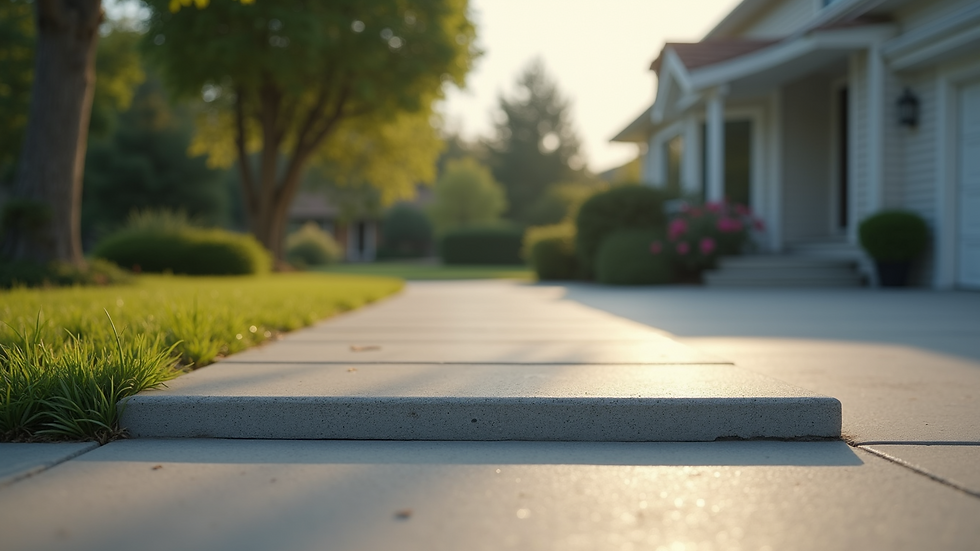The Impact of Spring Thaw on Concrete: Uncovering the Hidden Dangers
- John Linehan

- Mar 17
- 3 min read
As winter fades and spring emerges, many people look forward to warmer weather and blooming flowers. But for homeowners and business owners, this time of year can bring hidden risks, particularly for concrete structures. One major concern during the spring thaw is its impact on concrete surfaces, leading to issues like sunken concrete.
As temperatures rise and snow melts, the ground changes and affects the stability of concrete slabs and walkways. Knowing how spring thaw can deteriorate concrete is vital for maintaining the integrity of driveways, patios, and other outdoor structures.
What Causes Sunken Concrete?
Sunken concrete occurs when the ground beneath a concrete slab sinks, leading to uneven surfaces. While various factors contribute to this problem, the spring thaw is a key player.
When snow melts, the moisture can saturate the soil. If the ground is still frozen, it won't absorb the water properly. As the soil becomes saturated, it may lose stability, resulting in erosion or washout. A study from the Concrete Foundation Association revealed that about 40% of sunken concrete issues are linked to moisture and soil erosion. As voids form beneath the concrete, it can lead to settling or sinking.
Additionally, clay-heavy soils can expand and contract with changing temperatures and moisture levels. For example, clay soil can swell by up to 20% when wet, which intensifies movement under concrete slabs and causes misalignments.

Understanding the Spring Thaw Process
To appreciate the effects of spring thaw on concrete, it’s essential to understand the thawing process. As winter ends, temperatures rise gradually, thawing the upper layers of soil first.
However, deeper layers may remain frozen, creating a “frozen barrier.” When temperatures continue to rise and the snow melts, the accumulated water has trouble penetrating this frozen layer. Instead, it collects on the surface or seeps into cracks in the concrete.
Once the ground thaws completely, the water from melted snow needs to drain. Depending on the soil's absorption rate, this can lead to pooling around concrete foundations. According to the U.S. Environmental Protection Agency, nearly 30% of water-related issues in residential properties stem from inadequate drainage during spring thaw.
Identifying Signs of Sunken Concrete
Spotting sunken concrete early is crucial to prevent extensive damage. Here are key signs to watch for:
Uneven surfaces: If you notice concrete areas that sag or dip, there may be a problem.
Cracks: Look for horizontal or vertical cracks in your concrete, as these may indicate changes in the soil.
Water pooling: Accumulated water in specific areas after rain or snowmelt can signal uneven surfaces.
Addressing these signs quickly can save you from greater complications down the road.

Preventing Sunken Concrete
While the spring thaw can lead to problems, several preventive measures can be taken:
Proper Drainage: Ensure your property has effective drainage. This may mean grading the landscape to redirect water away from concrete surfaces or installing French drains. Statistics show that proper drainage can reduce the risk of sinking by as much as 50%.
Regular Maintenance: Inspect your concrete regularly for cracks or wear. Sealing cracks can prevent water from infiltrating concrete and the soil beneath. According to experts, a well-maintained concrete surface can last up to 30 years longer than one that is neglected.
Taking these steps can safeguard your concrete surfaces during the thawing process and save you time and money.
When to Consider Professional Help
In certain situations, sunken concrete may require professional assistance. If the issues are severe or if you are unsure about what to do, consulting a concrete specialist can be beneficial. They can assess the damage, suggest repair methods, and recommend long-term solutions to avoid future issues.
Repair options might include mudjacking, which raises sunken slabs by injecting a mixture underneath, or full replacement if the concrete is significantly damaged.

Closing Thoughts
The arrival of spring brings blooming flowers and warmer days, but it also reveals potential dangers for concrete surfaces. By understanding how spring thaw leads to sunken concrete, homeowners and property owners can take proactive measures.
Recognizing early warning signs, applying preventive strategies, and addressing issues immediately will help protect your concrete investments. With this knowledge and approach, your concrete can remain stable and safe year after year.
Being aware of the hidden dangers associated with spring thaw allows you to enjoy the beauty of the season without the worry of costly repairs lurking beneath your feet.



Comments